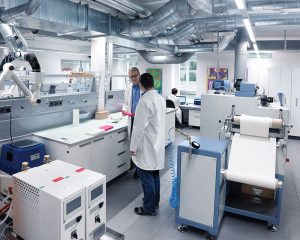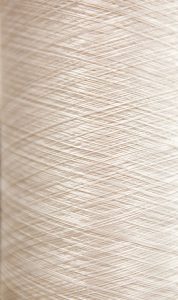
Antimicrobial textile products continue to play a role in odor control as well as controlling the spread of infectious microorganisms.
By Bob Deerin
An antimicrobial is an agent that kills microorganisms or inhibits their growth. Antimicrobial fibers then are textiles to which antimicrobial agents have been applied, either at the surface or within the fibers. Additives can be introduced to the fiber during spinning or extrusion, combined with dyes or pigments or applied as a finishing process. The chosen method is determined by a variety of factors including final use of the fabric, the capability of the manufacturer and budget.
The Fight Against Microbes
The National Institutes of Health reports that microbes actually outnumber a human’s cells by 10 to 1. To be fair, not all microbes are bad, but inhibiting the unchecked growth of microbes in contemporary society can be of critical importance as these pathogens, bacteria, and fungi quickly multiply and can lead to adverse health effects. A 2016 study by Morais and colleagues found that some bacteria populations can double every 20 to 30 minutes under ideal conditions, meaning that one single bacteria cell can increase to 1,048,576 cells in just seven hours.
Textiles’ large surface area and ability to retain moisture enable microorganism growth. This growth leads to a host of unpleasant effects for both the material and the end user. The growth of microorganisms reduces the textile’s mechanical strength, stains the fabric and lets other, more pernicious microbes breed. This is one of the reasons apparel is packaged in airtight bundles; one bad microbe in a moisture rich cargo container can ruin a whole shipment of textiles.
The effect on the end user’s health is even more important. Unchecked microbe growth leads to odors, infection, and the possibility of contamination. Since textile goods, particularly those made from natural fibers provide an excellent environment for microorganisms to grow, the need to protect and preserve them became fundamental. Therefore, these fibers are of key importance in sanitation and medical applications.

Where Antimicrobial Products Are Used
Antibacterial textiles are used where moisture and microbes meet. The materials see use in a variety of applications including healthcare; hygiene; medical devices; sportswear; food packaging; storage; thermal and mechanical protection; automotive textiles; heating, ventilation and air conditioning; air filters; and water purification systems. They are used to protect healthcare personnel with functional clothing as well as fabrics all around the home, including socks, mattresses, baby diapers and coverings.
Anywhere there are substances for the microorganism to feed on, antimicrobial fibers can be seen in some shape or fashion. For example, substances added to fibers, such as lubricants, antistatics, natural-based auxiliaries — including sizes, thickeners and hand modifiers — and dirt provide a food source for microorganisms. Antimicrobials of varying strength are used in order to prevent, inhibit, remove or kill microbes.
Antimicrobials Throughout History
Application of natural antimicrobial agents on textiles dates back to antiquity, when the ancient Egyptians used spices and herbs to preserve mummy wraps. Hundreds of years ago, the Chinese used bamboo — which contains an antimicrobial substance called bamboo-kun — in housing structures and design.
During World War II, both the Allied and the Axis powers used antimicrobials to prevent textiles from rotting. Tentage, tarpaulins, and truck covers needed to be protected from microbes born of heavy rain and snow that would eat through the fibers. Cotton duck, webbing, and other military fabrics were treated with mixes of chlorinated waxes, copper and antimony salts that stiffened the fabrics and gave them a distinct odor.
Modern Day Fabrics
During World War II, the polluting effects of antimicrobials was not considered, and just about any chemical compound was used to protect the precious military gear. However, during the 1960s, after serious health effects were found due to an overuse of chemical agents, more attention was paid to how these compounds affected the earth.
Antimicrobial textiles had entered the modern era. Following the 1962 publishing of the groundbreaking Rachel Carson book Silent Spring, ecologists, scientists, industrial chemists, and the public and private organizations that hired them, worked hand-in-hand to create more eco-friendly antibiotics.
Marketing Language Restrictions
Today, you can’t just slap an antimicrobial fiber sticker on a random textile and expect to go to market. The Food and Drug Administration monitors and regulates the language producers can use when selling their products. Scientists are working hard to try and find environmentally-friendly ways to control bacteria while preventing antibiotic resistance and resistant bacteria, therefore trade secrets, patents, and language surrounding antimicrobial fabrics is highly guarded.
Figure 1 provides an idea of the varying degrees of the term antimicrobial. Manufacturers and sellers of antimicrobial fabrics are limited in terms of the marketing language they can use, and heavy fines exist for wrongdoers who claim that their product is stronger or weaker than it actually is.
Creating An Antimicrobial Treatment
Besides being efficient against microorganisms, the treatment performed on a textile needs to satisfy the following different requirements:
- Suitable for textile processing;
- Durable during laundering, dry cleaning and hot pressing;
- Safe for use on skin or area of application; and
- Conducive to the biology of the planet.
These five needs always are counterbalanced by a need for frugality and budgetary constraints.
Eco-Friendliness: The Final Requirement
In recent years, innovative aspects on the use of coated fabrics have been revealed. Coatings can be applied to fabrics to influence their light reflectivity, electrical conductivity and thermal insulation, or to serve decorative purposes. Brands like BioShield®, Sanitized®, and Biofresh® have emerged as industry leaders by following the first four requirements. However, as we enter 2017, the products that will stand out will be the ones that meet all five requirements — and do so in an economical way.
Commercial opportunities abound for antimicrobial fabrics. There are obvious unfulfilled needs for odor control, degradation prevention, and controlling the spread of infectious microorganisms.
Editor’s Note: Since 2002, Bob Deerin has been president and CEO of Prime Life Fibers, a company that produces environmentally friendly, washable, reusable — and antimicrobial — incontinence wear. Learn more at weareverincontinence.com.
January/February 2017




